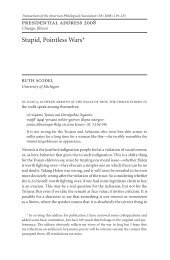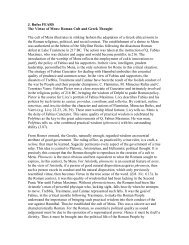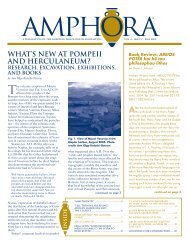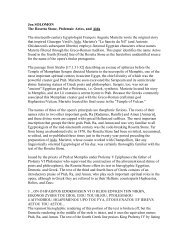classics rewritten in stone: the art of anita huffington - American ...
classics rewritten in stone: the art of anita huffington - American ...
classics rewritten in stone: the art of anita huffington - American ...
You also want an ePaper? Increase the reach of your titles
YUMPU automatically turns print PDFs into web optimized ePapers that Google loves.
HERODOTUS EARTH: MAPPING AND NETWORKING THE HISTORIES<br />
cont<strong>in</strong>ued from page 11<br />
Fig. 26. Co-reference network density<br />
(territories). Key: <strong>the</strong> thicker and darker<br />
<strong>the</strong> l<strong>in</strong>e, <strong>the</strong> stronger <strong>the</strong> connection.<br />
how space is represented <strong>in</strong> <strong>the</strong> Histories.<br />
In <strong>the</strong> example just cited, <strong>the</strong>re is little<br />
sense <strong>of</strong> a Greek-barbarian polarity at<br />
play, o<strong>the</strong>r than <strong>in</strong> <strong>the</strong> rhetoric that<br />
Aristagoras employs (for <strong>in</strong>stance, ask<strong>in</strong>g<br />
whe<strong>the</strong>r <strong>the</strong>re was really anyth<strong>in</strong>g to be<br />
feared from a people who wore trousers<br />
– what could be more unmanly than<br />
that!): <strong>in</strong>stead, Herodotus presents a<br />
series <strong>of</strong> ‘networks’ – <strong>the</strong> str<strong>in</strong>g <strong>of</strong> places<br />
that Aristagoras mentions <strong>in</strong> his attempt<br />
to show how easy conquest would be<br />
and <strong>the</strong> very fact that a Greek from Ionia<br />
(<strong>the</strong> west coast <strong>of</strong> Turkey) goes to a city<br />
on ma<strong>in</strong>land Greece for an alliance <strong>in</strong><br />
<strong>the</strong> first place. The HESTIA database <strong>of</strong><br />
spatial references allows us to identify<br />
quickly and efficiently connections<br />
between places mentioned by<br />
Herodotus <strong>in</strong> <strong>the</strong> same breath (i.e., <strong>in</strong> a<br />
chapter), represent those connections <strong>in</strong><br />
various graphic forms, and consider <strong>the</strong>ir<br />
significance. Moreover, as well as provid<strong>in</strong>g<br />
a general sense <strong>of</strong> <strong>the</strong> broad ‘network’<br />
culture <strong>of</strong> <strong>the</strong> Histories, we will<br />
also be able to generate a f<strong>in</strong>er gra<strong>in</strong> <strong>of</strong><br />
analysis by count<strong>in</strong>g <strong>the</strong> relative<br />
strengths <strong>of</strong> <strong>the</strong> components with<strong>in</strong> any<br />
given network: that is to say, we will be<br />
able to identify <strong>the</strong> “hot-spots” <strong>of</strong> <strong>the</strong><br />
network culture – those places that have<br />
<strong>the</strong> most “hits” or “degree centrality”<br />
with<strong>in</strong> a network – or else evaluate and<br />
represent <strong>the</strong> “thickness” <strong>of</strong> <strong>the</strong> connections<br />
between places <strong>the</strong>mselves.<br />
Figure 26 gives an example <strong>of</strong> one<br />
such network, depict<strong>in</strong>g l<strong>in</strong>kages among<br />
territories across <strong>the</strong> entire Histories. It<br />
traces <strong>the</strong> connections among Greece<br />
and o<strong>the</strong>r territories with<strong>in</strong> <strong>the</strong> Mediterranean<br />
world, primarily Italy, Thrace,<br />
Scythia, Persia, and Egypt. Interest<strong>in</strong>gly,<br />
however, from<br />
this broad brushstroke<br />
image <strong>of</strong><br />
Herodotus’ world,<br />
<strong>the</strong> territory that<br />
emerges as hav<strong>in</strong>g<br />
<strong>the</strong> strongest connections<br />
<strong>in</strong> this<br />
basic network culture<br />
is not<br />
Greece, but<br />
Egypt: each one<br />
<strong>of</strong> <strong>the</strong> l<strong>in</strong>ks that<br />
Egypt has to o<strong>the</strong>r<br />
territories scores<br />
<strong>in</strong> <strong>the</strong> highest rat<strong>in</strong>g.<br />
While this<br />
may not have been anticipated, it does<br />
make sense on reflection, s<strong>in</strong>ce for a better<br />
p<strong>art</strong> <strong>of</strong> one book Herodotus uses<br />
Egypt as <strong>the</strong> touch<strong>stone</strong> aga<strong>in</strong>st which<br />
o<strong>the</strong>r cultures, <strong>in</strong>clud<strong>in</strong>g Persia and his<br />
own, Greece, are compared. It is its<br />
function as a reference po<strong>in</strong>t, <strong>the</strong>n, that<br />
allows Egypt to appear as <strong>the</strong> center <strong>of</strong><br />
Herodotus’ network picture <strong>of</strong> <strong>the</strong><br />
Mediterranean.<br />
It is unclear to us at this stage what<br />
new picture <strong>of</strong> space will emerge<br />
through our analysis, but we can be<br />
pretty certa<strong>in</strong> <strong>of</strong> two th<strong>in</strong>gs. First, we<br />
don’t expect <strong>the</strong> network maps to<br />
reflect <strong>the</strong> historical reality, but ra<strong>the</strong>r<br />
Herodotus’ preconceptions and knowledge<br />
base – or those <strong>of</strong> his historical<br />
agents. Such views may be a useful<br />
complement to <strong>the</strong> picture that can be<br />
o<strong>the</strong>rwise reconstructed by archaeologists<br />
and ancient historians, s<strong>in</strong>ce <strong>the</strong>y<br />
may provide an <strong>in</strong>sight <strong>in</strong>to <strong>the</strong> “cultural<br />
mentality” <strong>in</strong>form<strong>in</strong>g Herodotus’ world.<br />
Second, we expect our <strong>in</strong>terpretation <strong>of</strong><br />
Herodotus’ world <strong>in</strong> <strong>the</strong> end to differ<br />
radically from both <strong>the</strong> “satellite” image<br />
<strong>of</strong> <strong>the</strong> E<strong>art</strong>h that our technology generates,<br />
and <strong>the</strong> two-dimensional C<strong>art</strong>esian<br />
maps that have dom<strong>in</strong>ated western<br />
th<strong>in</strong>k<strong>in</strong>g for centuries. Indeed, we anticipate<br />
generat<strong>in</strong>g maps that are “topologically”<br />
ra<strong>the</strong>r than geographically based,<br />
much like <strong>the</strong> famous schematic diagram<br />
<strong>of</strong> <strong>the</strong> London Underground (see<br />
http://en.wikipedia.org/wiki/Tube_map).<br />
These maps will represent <strong>the</strong> distance<br />
between places mentioned <strong>in</strong><br />
Herodotus’ Histories <strong>in</strong> relation to <strong>the</strong><br />
number and strength <strong>of</strong> <strong>the</strong> connections<br />
between <strong>the</strong>m, ra<strong>the</strong>r than accord<strong>in</strong>g to<br />
<strong>the</strong>ir “real” physical locations.<br />
All <strong>of</strong> <strong>the</strong> images that we generate<br />
will be freely available to all on our<br />
website under a Creative Commons<br />
License. Fur<strong>the</strong>rmore, a l<strong>in</strong>k from our<br />
website to <strong>the</strong> database, which conta<strong>in</strong>s<br />
all <strong>of</strong> <strong>the</strong> spatial data that we have captured,<br />
will allow users to generate <strong>the</strong>ir<br />
own maps. F<strong>in</strong>ally, all <strong>of</strong> <strong>the</strong> s<strong>of</strong>tware<br />
that we are us<strong>in</strong>g and develop<strong>in</strong>g is<br />
open source, mean<strong>in</strong>g that it can be<br />
reused for o<strong>the</strong>r similar projects and<br />
improved upon. We believe that it is<br />
ultimately this pr<strong>in</strong>ciple <strong>of</strong> openness<br />
and freedom that does most justice to<br />
<strong>the</strong> world that Herodotus represents.<br />
Dr Elton Barker (e.t.e.barker@open.ac.uk)<br />
Pr<strong>in</strong>cipal Investigator) is a lecturer <strong>in</strong> Classical<br />
Studies at <strong>the</strong> Open University, after hav<strong>in</strong>g<br />
previously been a college lecturer at Christ<br />
Church, Oxford for five years. Author <strong>of</strong> a<br />
series <strong>of</strong> <strong>art</strong>icles on epic poetry and <strong>the</strong> epic<br />
cycle, Sophocles and Herodotus, he has recently<br />
published a book with Oxford University Press<br />
entitled Enter<strong>in</strong>g <strong>the</strong> Agon: Dissent and<br />
Authority <strong>in</strong> Homer, Historiography and<br />
Tragedy (January 2009).<br />
Dr Stefan Bouzarovski (Co-Investigator)<br />
is a Lecturer <strong>in</strong> Human Geography at <strong>the</strong><br />
School <strong>of</strong> Geography, E<strong>art</strong>h and Environmental<br />
Sciences at <strong>the</strong> University <strong>of</strong> Birm<strong>in</strong>gham,<br />
UK. He is also a Visit<strong>in</strong>g Pr<strong>of</strong>essor<br />
at <strong>the</strong> Faculty <strong>of</strong> Science at Charles University<br />
<strong>in</strong> Prague, Czech Republic and an<br />
External Pr<strong>of</strong>essor at <strong>the</strong> Dep<strong>art</strong>ment <strong>of</strong><br />
Economic Geography, University <strong>of</strong> Gdansk,<br />
Poland. His work is p<strong>art</strong>ly supported by <strong>the</strong><br />
M<strong>in</strong>istry <strong>of</strong> Education, Youth and Sports <strong>of</strong><br />
<strong>the</strong> Czech Republic, under project no.<br />
MSM0021620831 titled ’Geographic Systems<br />
and Risk Processes <strong>in</strong> <strong>the</strong> Context <strong>of</strong><br />
Global Change and European Integration.’<br />
Christopher Pell<strong>in</strong>g (Co-Investigator) has<br />
been Regius Pr<strong>of</strong>essor <strong>of</strong> Greek at Oxford<br />
University s<strong>in</strong>ce 2003. His books <strong>in</strong>clude a<br />
commentary on Plutarch, Life <strong>of</strong> Antony<br />
(Cambridge, 1988), Literary Texts and<br />
<strong>the</strong> Greek Historian (London, 2000), and<br />
Plutarch and History (Swansea, 2002); he<br />
has also edited collections on Characterization<br />
and Individuality <strong>in</strong> Greek Literature<br />
(Oxford, 1990) and Greek Tragedy<br />
and <strong>the</strong> Historian (Oxford, 1997).<br />
Mr Leif Isaksen (ICT consultant) is<br />
currently study<strong>in</strong>g for a Ph.D. at <strong>the</strong> University<br />
<strong>of</strong> Southampton develop<strong>in</strong>g an assistive<br />
research framework to <strong>in</strong>tegrate <strong>in</strong>formation<br />
from across multiple excavation data repositories.<br />
Specializ<strong>in</strong>g <strong>in</strong> <strong>the</strong> application <strong>of</strong> ICT<br />
to <strong>the</strong> analysis <strong>of</strong> space <strong>in</strong> <strong>the</strong> ancient world,<br />
he moderates <strong>the</strong> Antiquist ICT and Cultural<br />
Heritage community.<br />
19



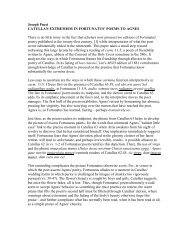
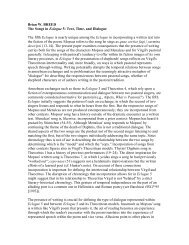
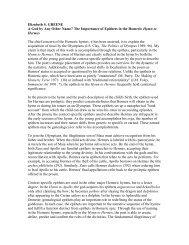

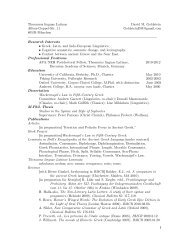
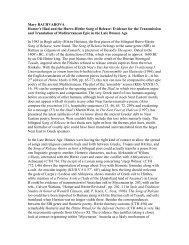

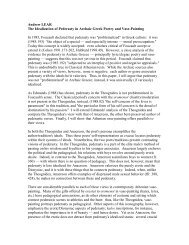
![John H. STARKS, Jr. [vo]cales vultus:Pantomime Actresses in Latin ...](https://img.yumpu.com/11930335/1/190x245/john-h-starks-jr-vocales-vultuspantomime-actresses-in-latin-.jpg?quality=85)
